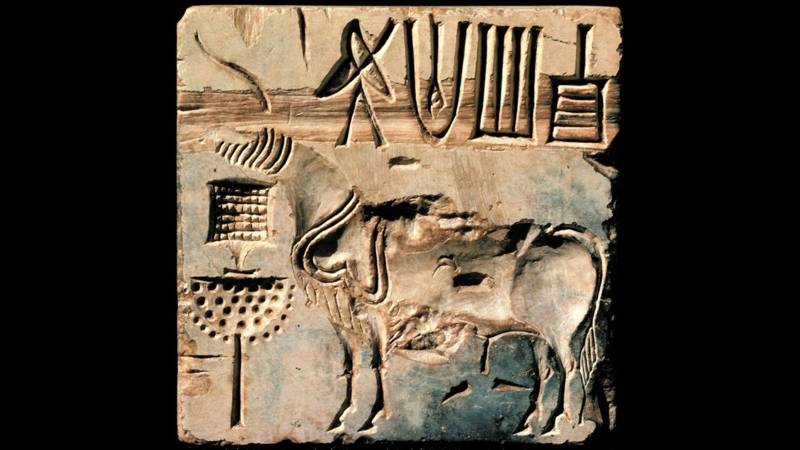
The ancient Indus Valley Civilisation, with its sophisticated urban planning and enigmatic script, continues to intrigue scholars and historians. A recent study offers a novel analysis of Indus Seal M-282, unearthed from the significant archaeological site of Mohenjo-Daro. By employing the proposed Sindhu Prakrit alphabet, the research delves into the relationship between the seal's iconography and its inscribed text, seeking to unlock the meaning behind its motifs.
The Indus script is one of the last great undeciphered writing systems from the ancient world. The new approach in this study treats the script as an alphabet, offering a fresh perspective on its interpretation. This analysis builds on the comprehensive documentation of Indus signs by eminent scholars like Iravatham Mahadevan and Asko Parpola, aiming to shed new light on this ancient mystery.
Through meticulous examination, the study proposes an empirical model to understand the compositional techniques and potential use of diacritics within the Indus script. The model posits that the script operates with approximately 40 primary signs, which are supplemented by additional symbols representing vowels, diphthongs, and aspirated consonants. These primary signs have been assigned phonetic values through comparisons with other ancient alphabetic scripts.
The concept of decipherment often hinges on the self-evident nature of the process, as noted by Mahadevan. For a syllabic or alphabetic script to be considered successfully deciphered, its phonetic elements should interlock in a way that provides clear evidence of its functionality.
Applying these alphabetic principles, the article presents an interpretation of the Indus script on iconographic seal M-282. The analysis investigates how the seal's iconography potentially complements and enhances the interpretation of the inscribed text. This approach suggests a close correlation between the seal's motifs and its written symbols, offering a richer understanding of Indus Valley communication and symbolism.
Inscribed Texts on Seal M-282

It is crucial to acknowledge that the Indus Script exhibits a unique phonological system, differentiating between ‘k’ and ‘q’, a distinction absent in contemporary Sanskritic and other Prakritic scripts. For a more in-depth analysis of the sign 'Pati' and the variation of the 'k' sound, refer to The Alphabet of Sindhu Prakrit.
This proposed alphabetic deciphering of the Indus script reveals a compelling correlation between decoded text and accompanying iconography
The seal inscription provides evidence of the Indus Script’s flexibility in employing diacritical marks. To further elucidate this point, a comparative example from Mahadevan’s Concordance (1977) is pertinent.

While a comprehensive analysis of the initial two signs and the potential significance of the "Ha Ha" sequence merits further investigation, this section concentrates on a particular aspect of the inscription: the application of the vowel diacritic. It is observed that modifying diacritics are commonly positioned before primary signs. By adhering to the proposed orthographic principles of the Indus Alphabet, deciphered as a script for Sindhu Prakrit, a meticulous examination of the diacritic P-125 provides crucial insights into the potential vocalic system and phonological structure of the Indus language.
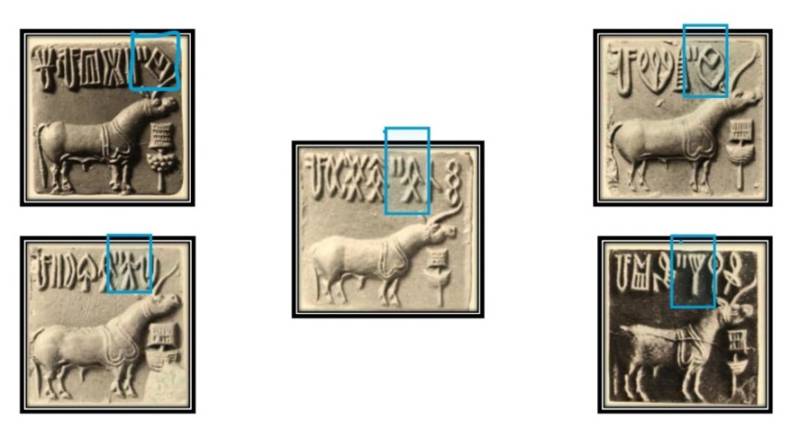
The inscription on the seal presents another interesting example of potential variability in diacritic placement. Sign P-127, characterised by its double strokes, is typically positioned at the upper left of sign P-376, as evidenced by numerous other Indus seals.
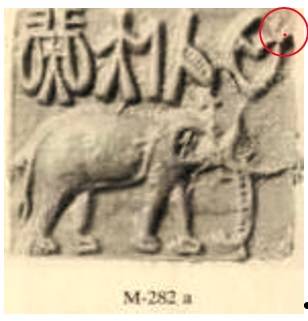
However, in this particular inscription, P-127 appears at the upper right of P-376.This deviation from the usual placement raises intriguing attention about the potential significance of diacritic location and application within the Indus script.
Iconographic Elements Possessing Symbolic Features
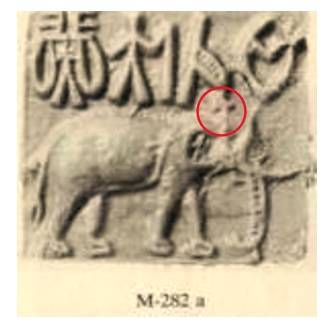
The Crown with Three Points
The Sanskrit term "makuṭa" primarily signifies a crown, tiara, or diadem. Monier-Williams' comprehensive dictionary elaborates on this, describing it as crescent-shaped, distinct from the pointed kirīṭa and the three-pointed mauli. It can also refer to a crest, peak, or even the head itself.
Other authoritative Sanskrit dictionaries like Shabda-Sagara, and Yates echo this core meaning, with additional synonyms like head-dress and coronet. The Pali equivalent, as per Pali-English dictionaries, is also "makuṭa" and carries the same connotation of a crest or crown.
Interestingly, the term extends beyond mere ornamentation. In the context of Shaivism, as explored in iconographical representations of Shiva, "Makuṭāgama" is one of the twenty-eight Siddhāntāgamas - sacred texts embodying the divine wisdom of Shiva, passed down through Parvati and acknowledged by Vishnu.
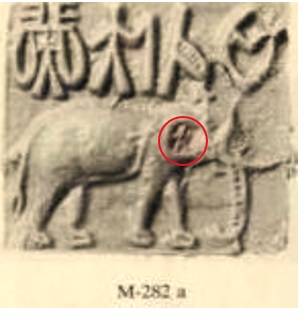
The Intriguing Fish Sign (P-60)
A careful examination of the iconography on seal M-282 reveals an intriguing anomaly: a diminutive fish sign (P-60) occupies the position typically reserved for the elephant's eye. The unconventional substitution of this element warrants closer scrutiny. To elucidate the potential significance of this sign, a detailed analysis of its meaning is imperative.

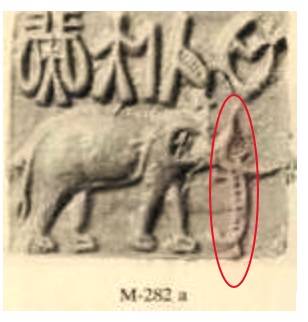
Multifaceted Meaning of Śa
The Sanskrit term "Śa" encapsulates a range of potent concepts. Apte V.S and Monier-Williams agree on its fundamental meaning as a "cutter" or "destroyer." This destructive force is further emphasised by its association with a weapon.
Significantly, both dictionaries also link "Śa" to the Shiva, known for his transformative and often destructive roles in mythology.
Unconventional Trunk
The proboscis depicted in this motif deviates from conventional representations, instead resembling an archaic weapon. This interpretation is reinforced by the sign substituted for the elephant's eye.
Based on the decipherment of the Indus Script as an alphabetic system, the textual content reveals distinct social strata correlated with specific motifs. The elephant motif is associated with the ruling class or political governance of the empire. The seal under examination signifies a sovereign ruler and their power.
Indus seals exhibit exceptional skill and precision in conveying symbolic messages through iconography. This mastery is evident in all seals adorned with images, demonstrating not only linguistic and writing proficiency but also artistic virtuosity. The integration of symbolic representations of diverse themes and concepts alongside the textual content is remarkable. A particularly striking feature of the Indus texts is their frequent and meticulous references to Mahadev Shiva and Uma Parvati. This phenomenon underscores a profound devotion to the divine couple.
The proposed alphabetic deciphering of the Indus script reveals a compelling correlation between decoded text and accompanying iconography. This congruence is further substantiated by numerous iconographic seals that demonstrate a similar level of consistency when interpreted through the lens of the suggested Sindhu Prakrit alphabet.
This research endeavours to position the alphabetic approach at the forefront of Indus script studies and stimulate broader scholarly engagement with this methodology. Constructive criticism and alternative perspectives are not only welcomed but actively encouraged. A re-evaluation of the Indus script as an alphabet holds the potential to unlock the enigmatic secrets of this civilisation and its rich historical tapestry.

